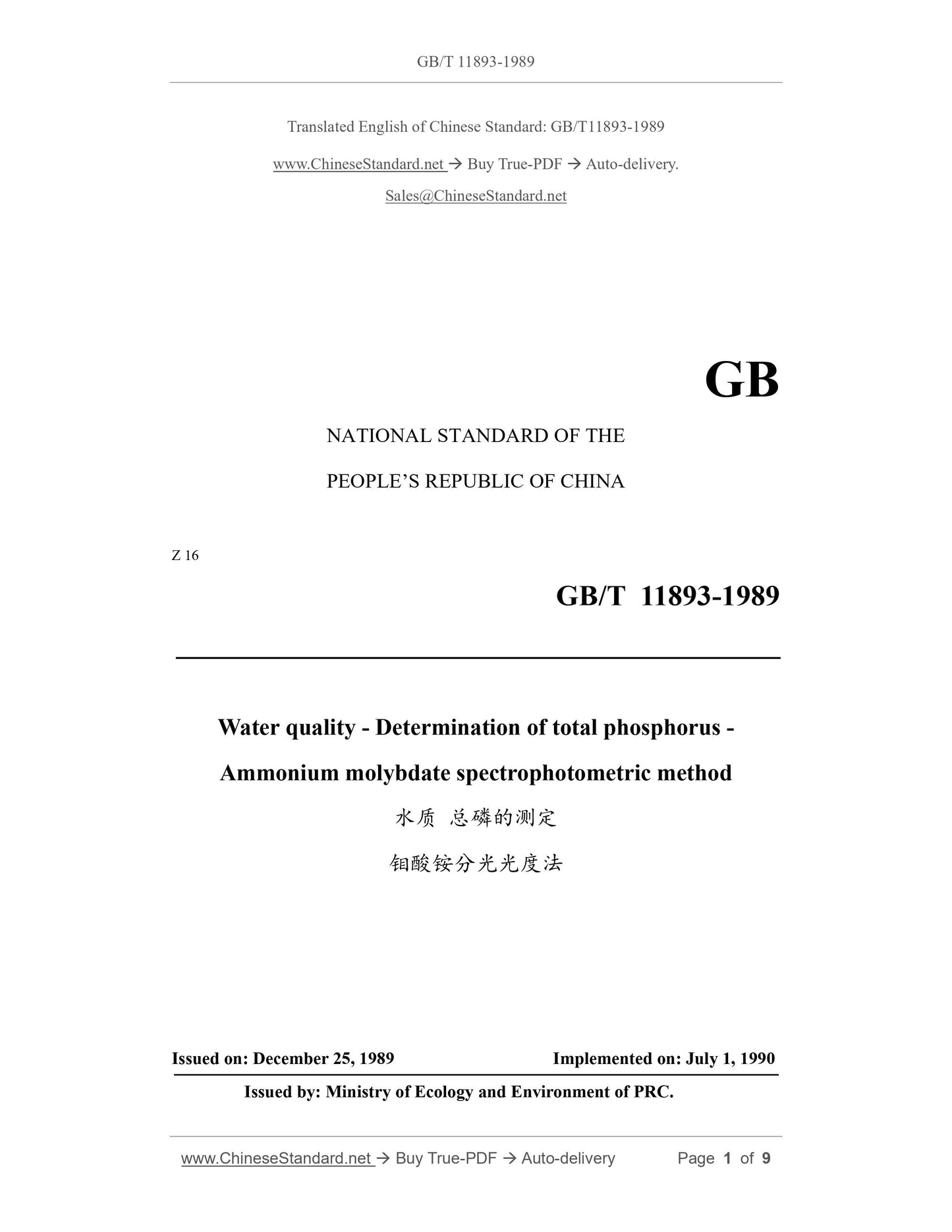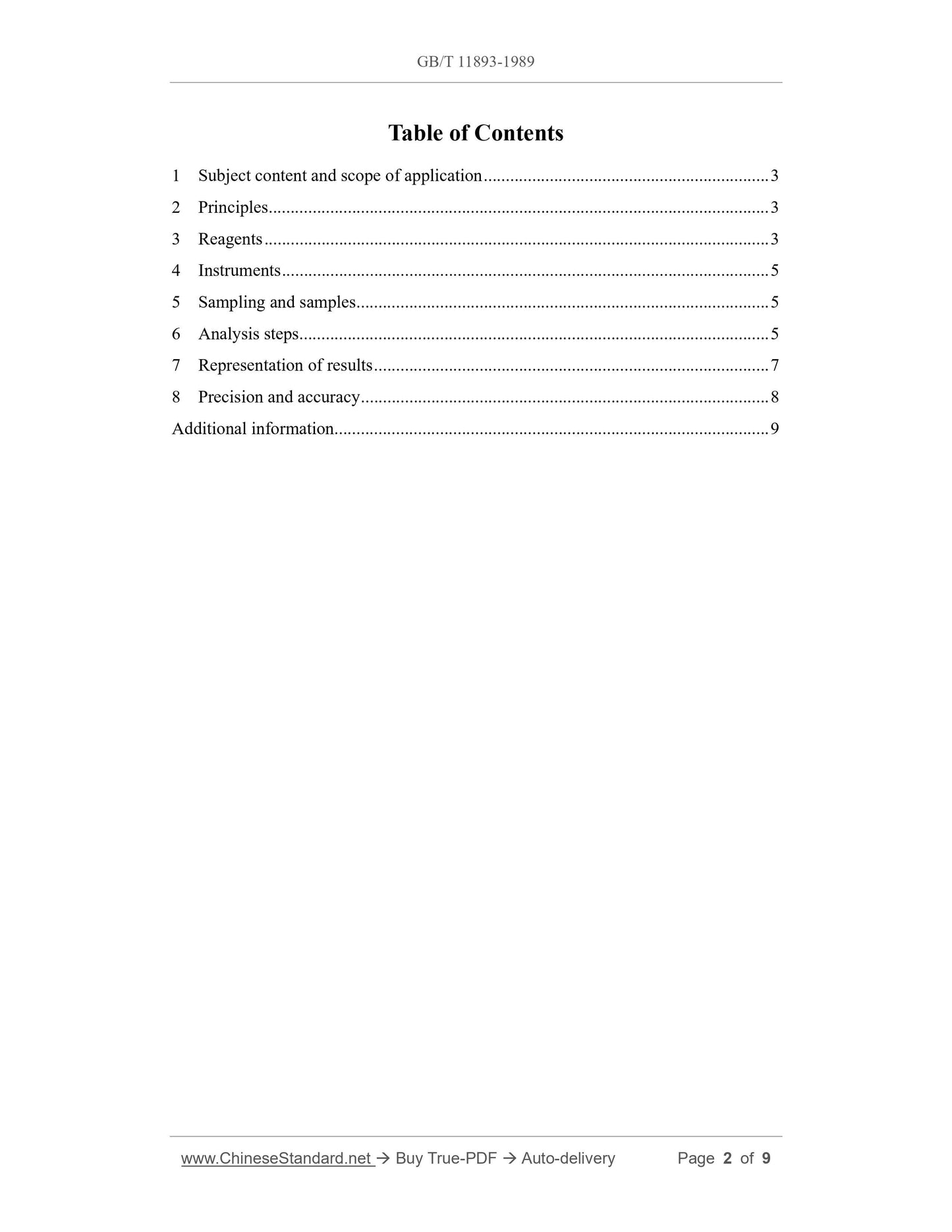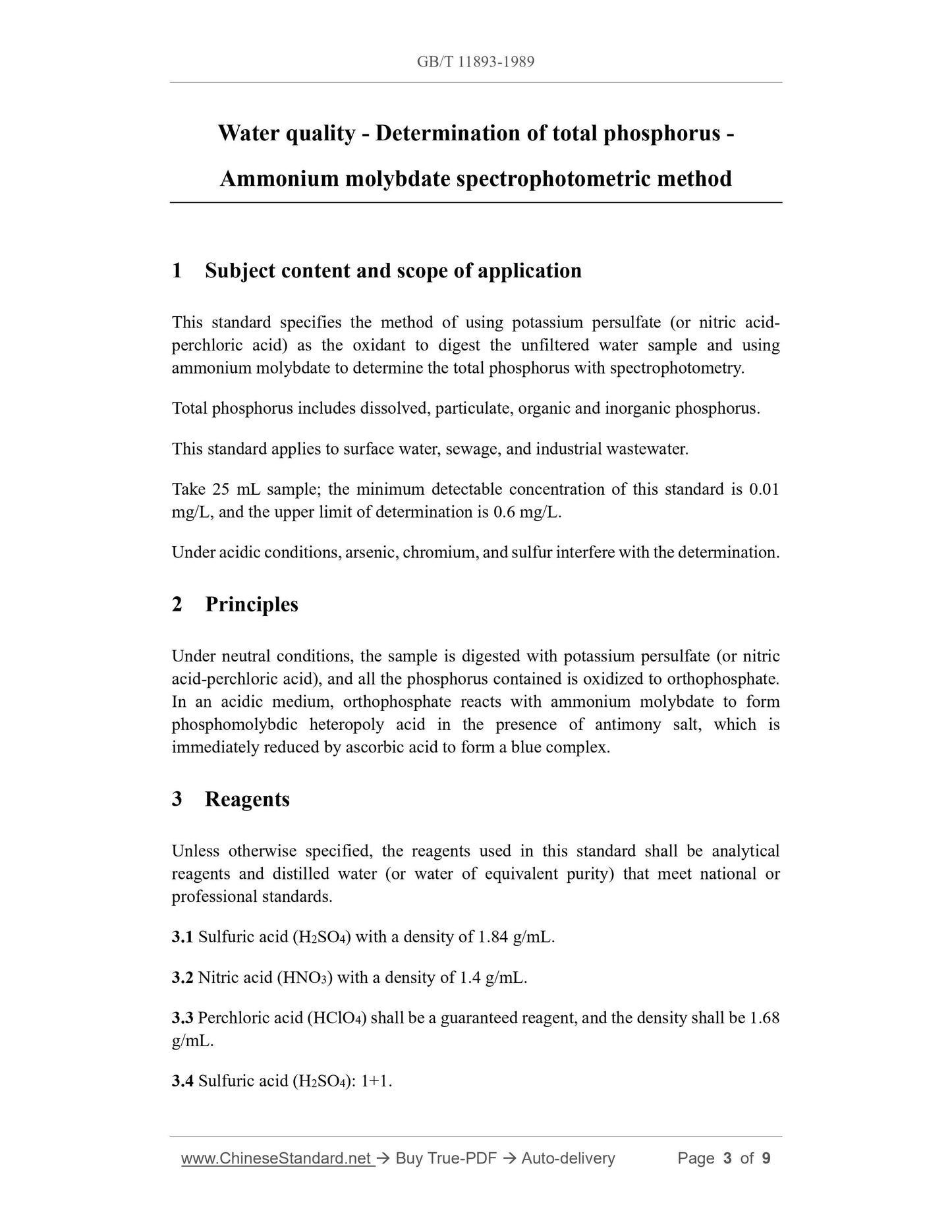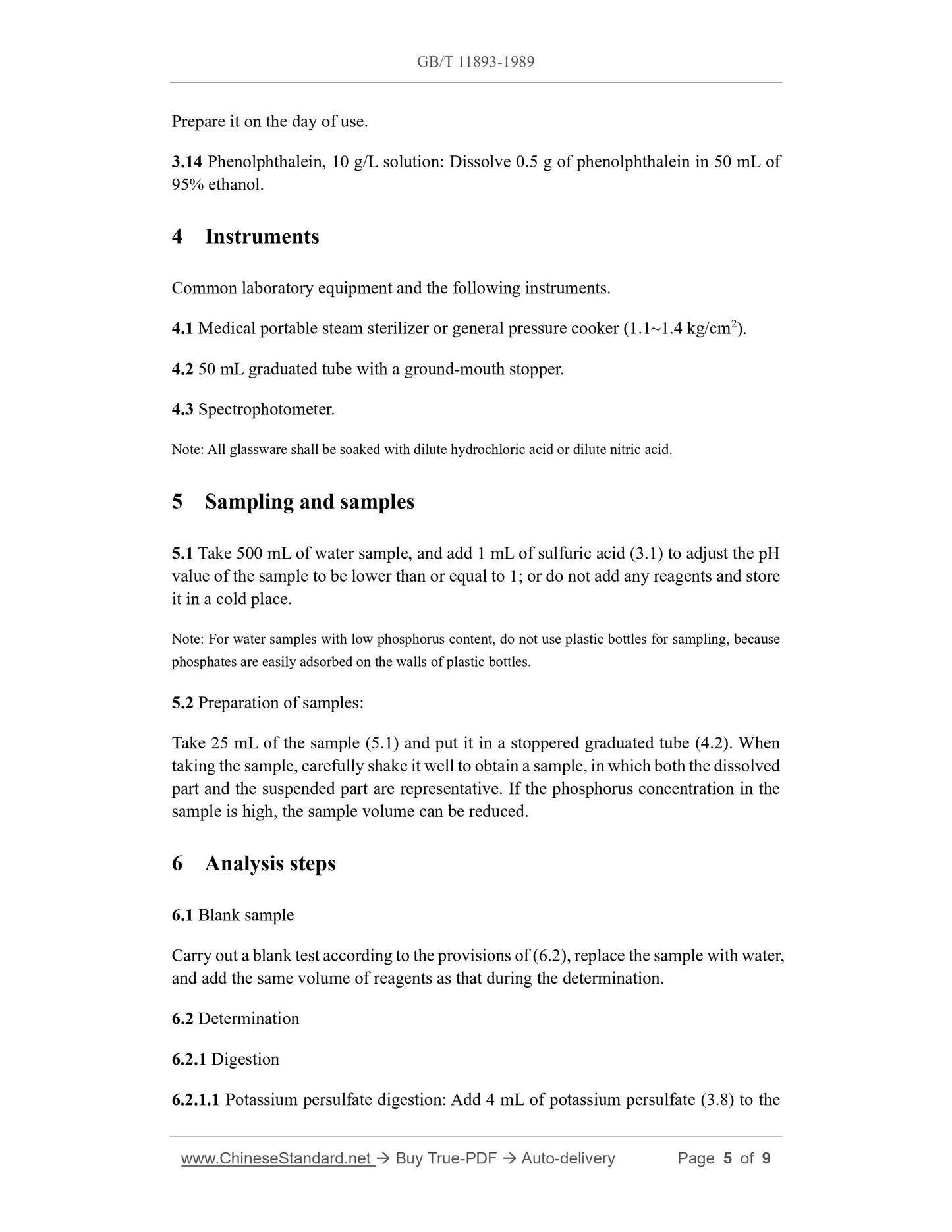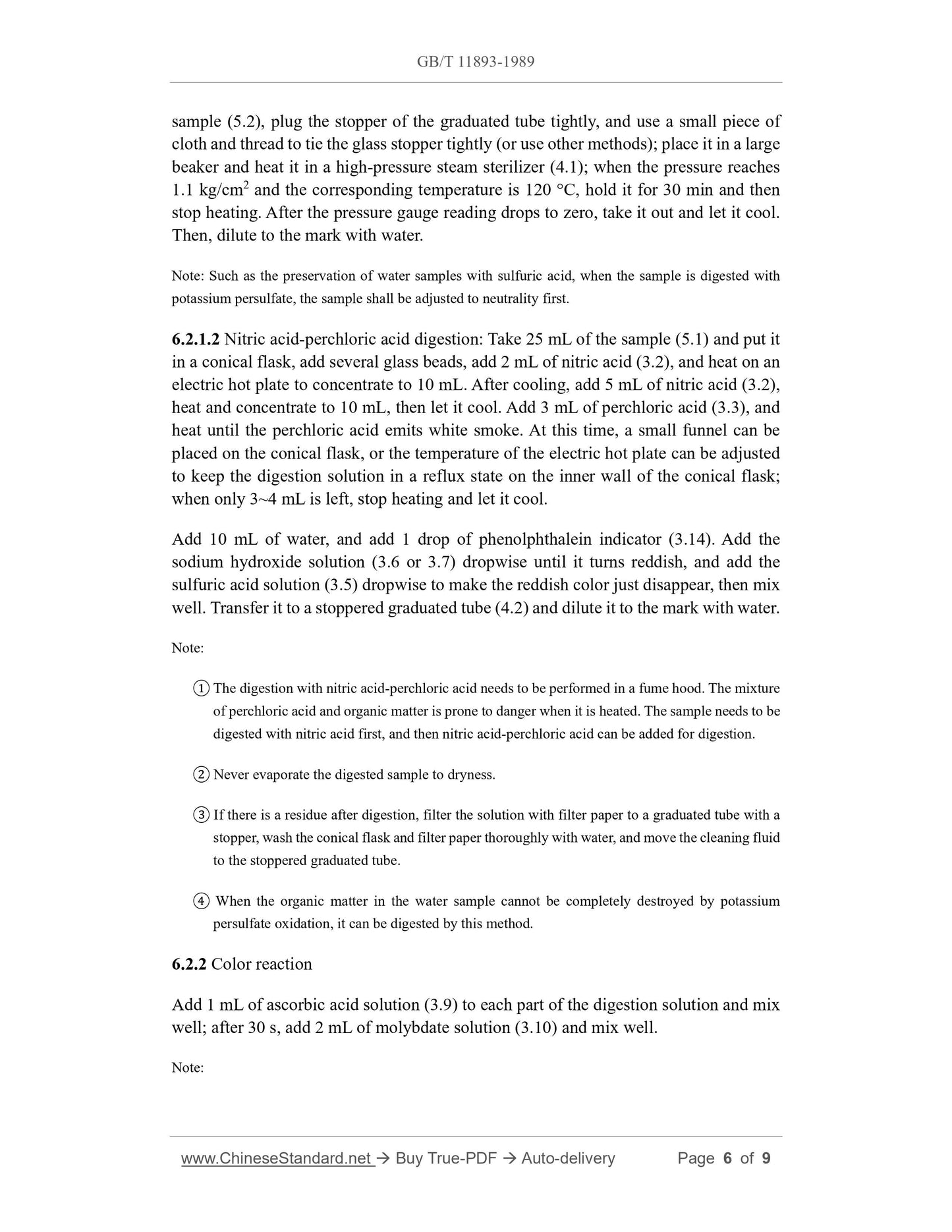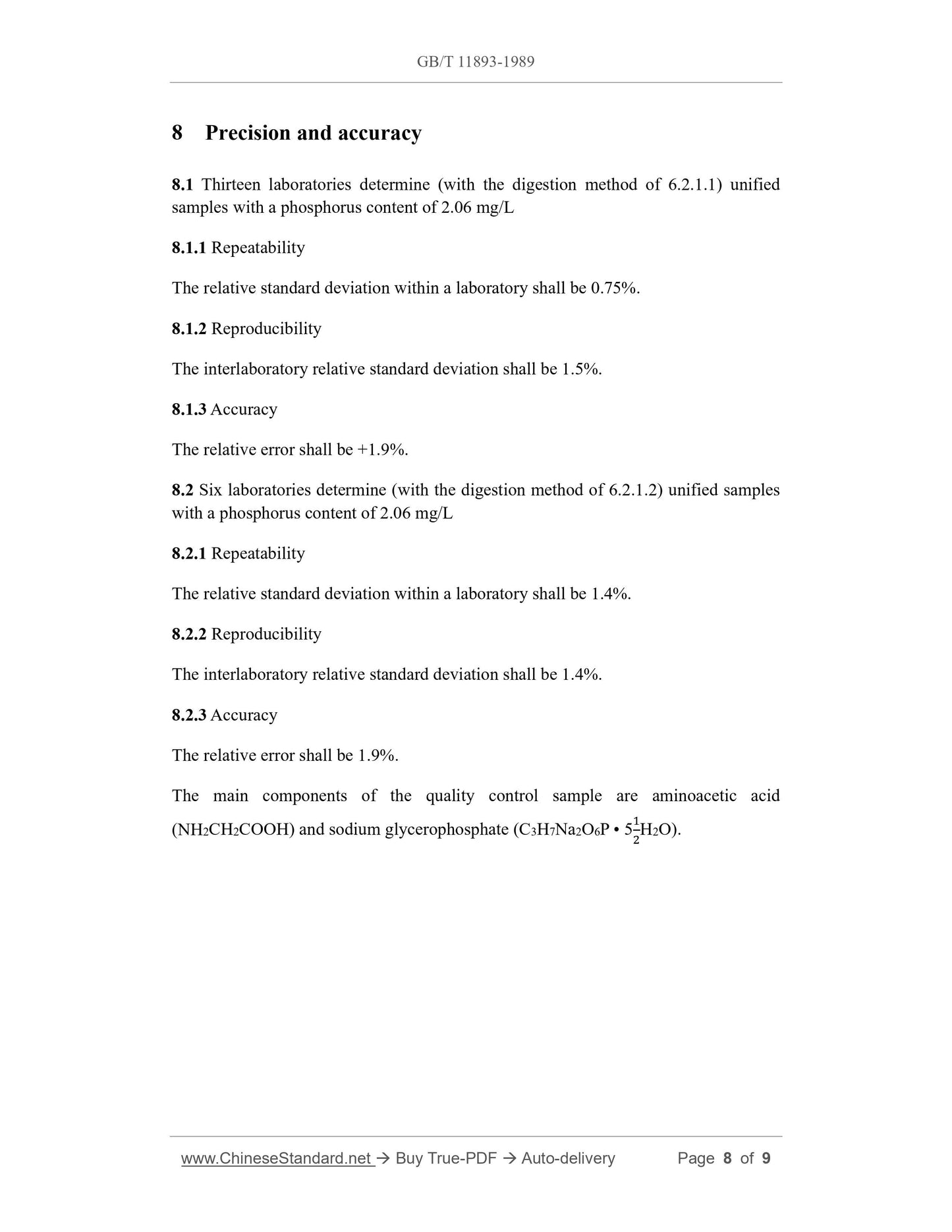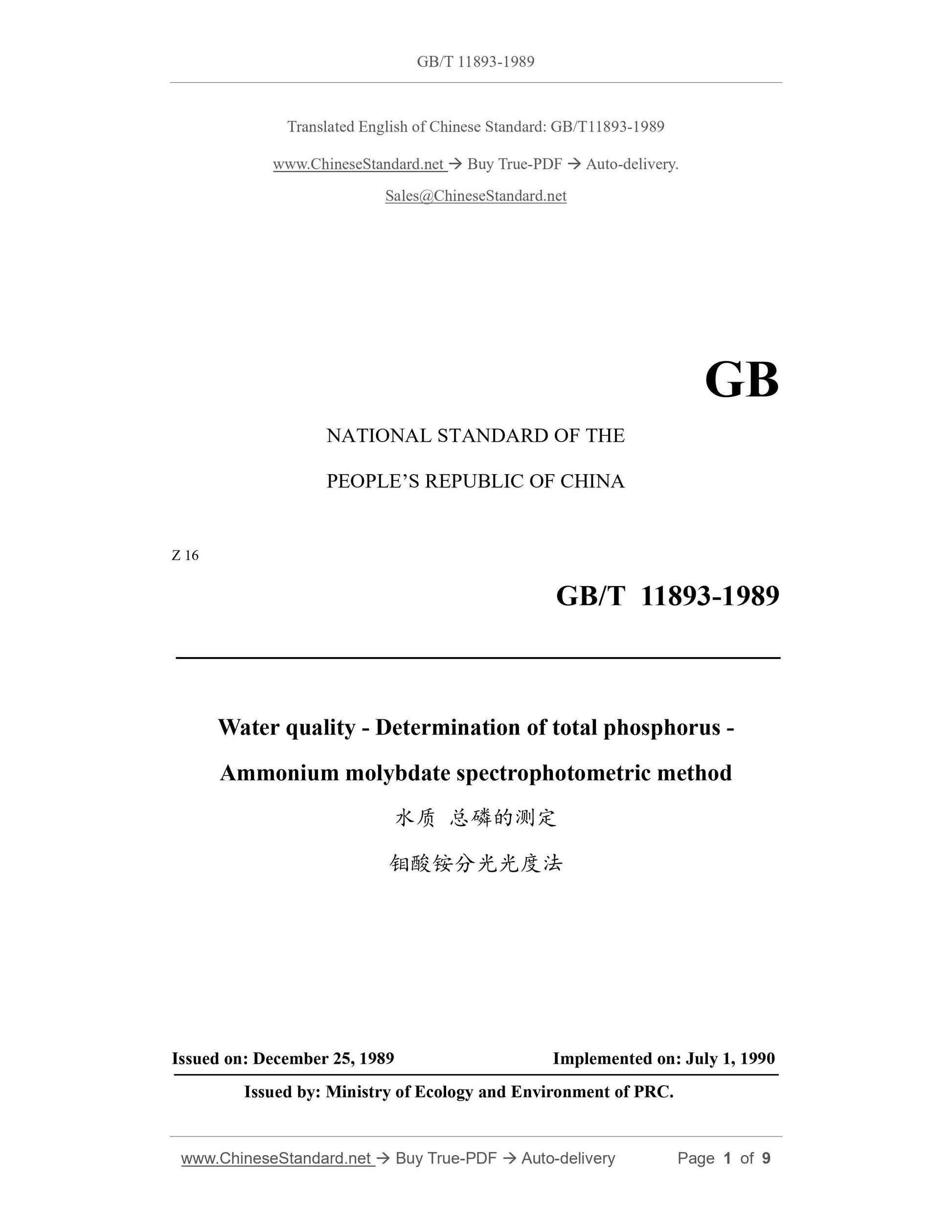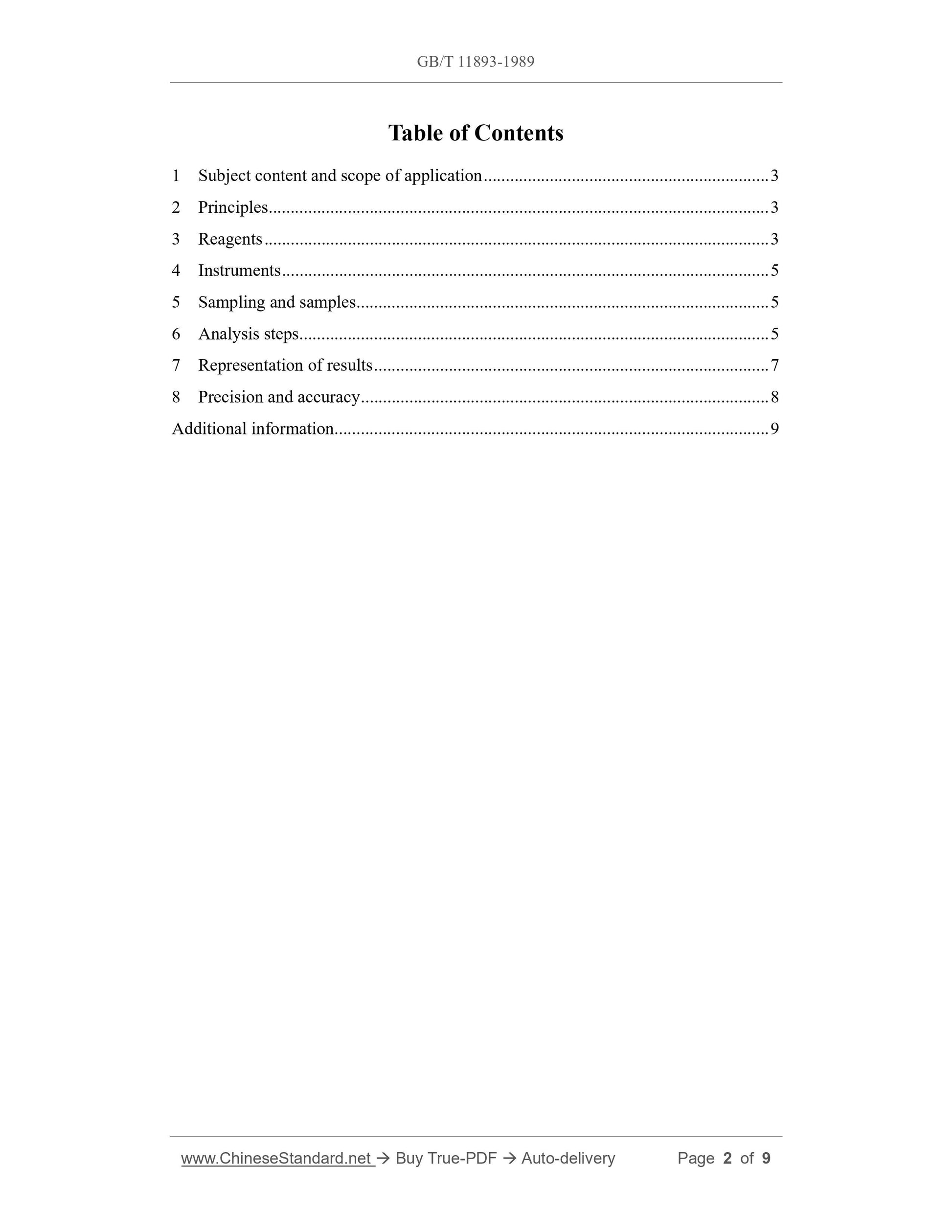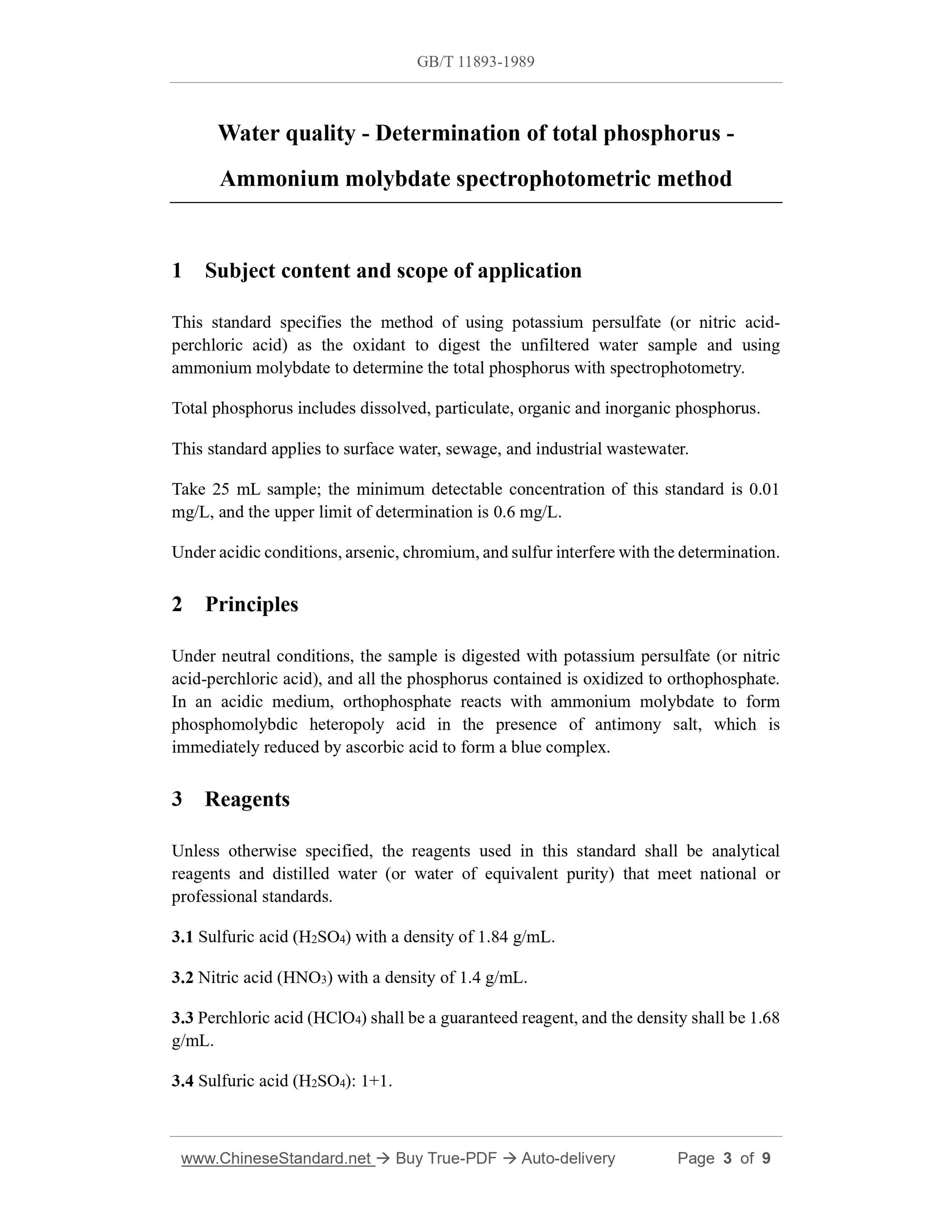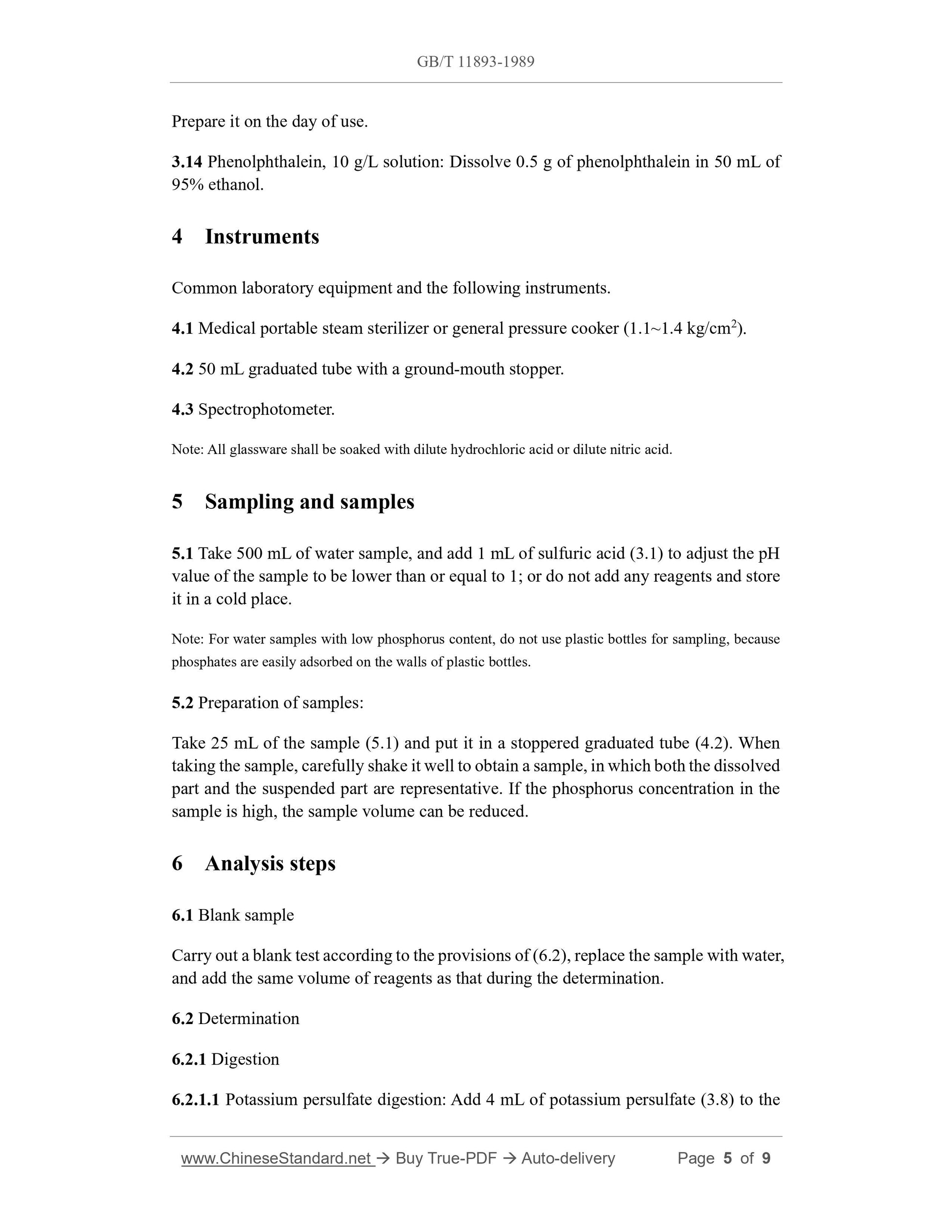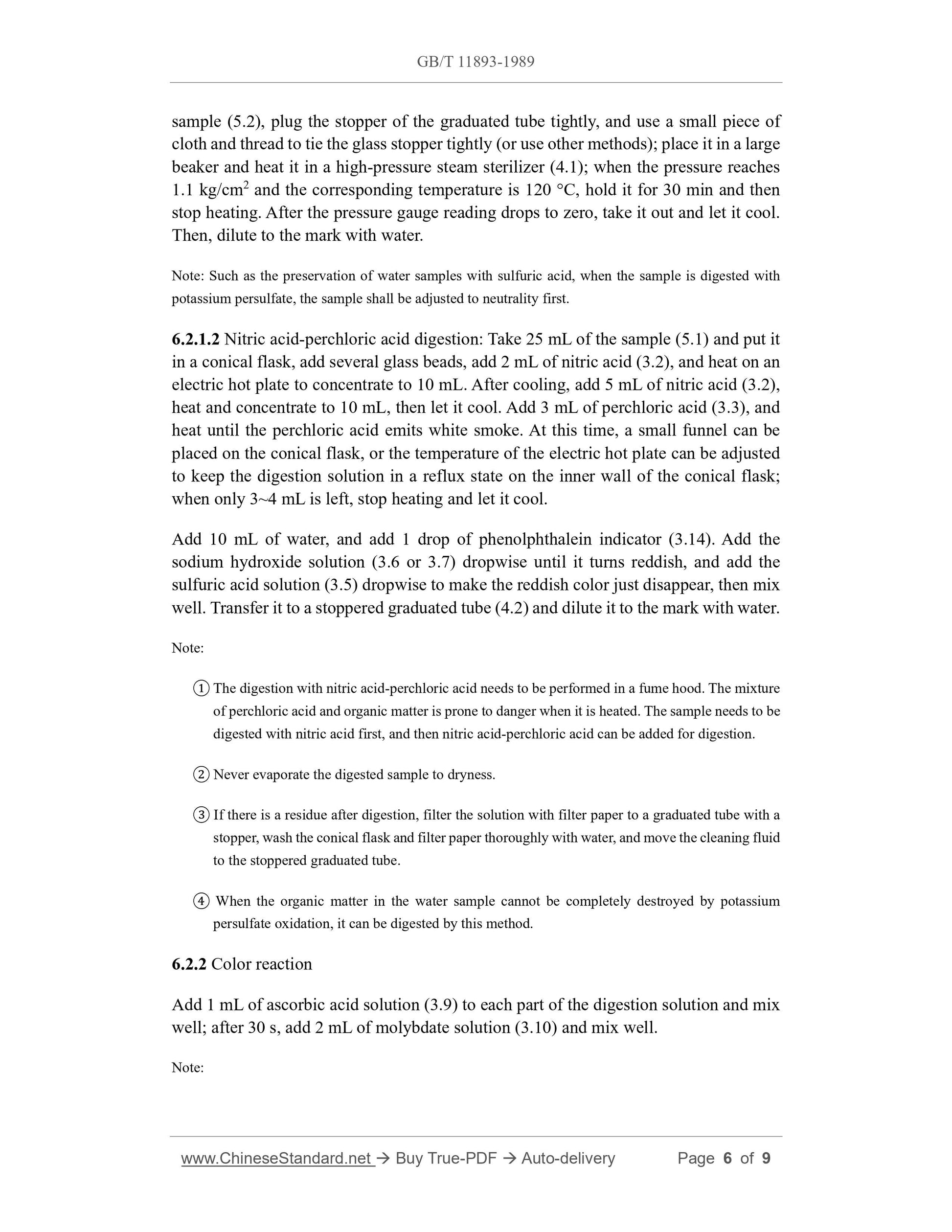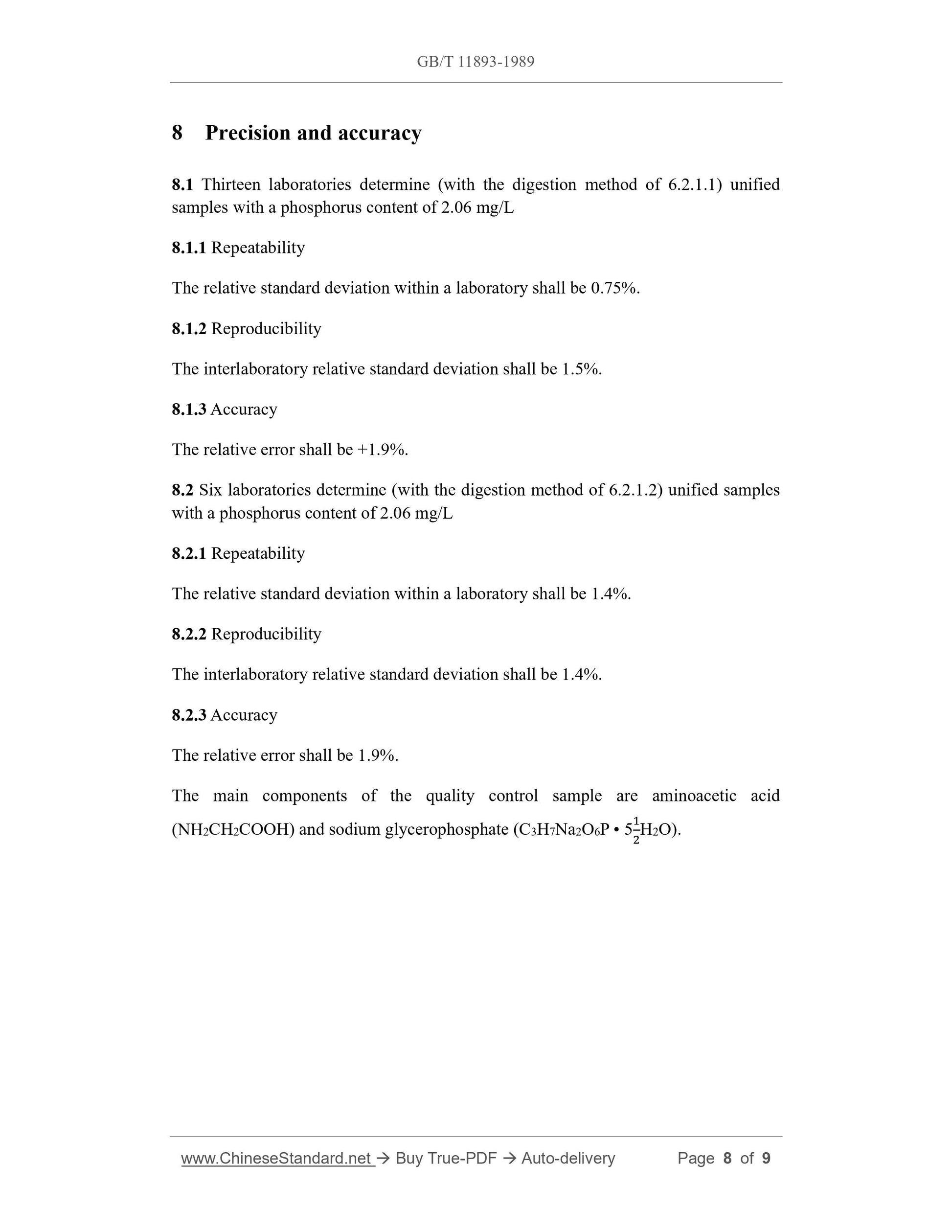1
/
of
6
www.ChineseStandard.us -- Field Test Asia Pte. Ltd.
GB/T 11893-1989 English PDF (GB/T11893-1989)
GB/T 11893-1989 English PDF (GB/T11893-1989)
Regular price
$70.00
Regular price
Sale price
$70.00
Unit price
/
per
Shipping calculated at checkout.
Couldn't load pickup availability
GB/T 11893-1989: Water quality. Determination of total phosphorus. Ammonium molybdate spectrophotometric method
Delivery: 9 seconds. Download (& Email) true-PDF + Invoice.
Get Quotation: Click GB/T 11893-1989 (Self-service in 1-minute)
Historical versions (Master-website): GB/T 11893-1989
Preview True-PDF (Reload/Scroll-down if blank)
GB/T 11893-1989
GB
NATIONAL STANDARD OF THE
PEOPLE’S REPUBLIC OF CHINA
Z 16
Water quality - Determination of total phosphorus -
Ammonium molybdate spectrophotometric method
ISSUED ON: DECEMBER 25, 1989
IMPLEMENTED ON: JULY 1, 1990
Issued by: Ministry of Ecology and Environment of PRC.
Table of Contents
1 Subject content and scope of application ... 3
2 Principles ... 3
3 Reagents ... 3
4 Instruments ... 5
5 Sampling and samples ... 5
6 Analysis steps ... 5
7 Representation of results ... 7
8 Precision and accuracy ... 8
Additional information ... 9
Water quality - Determination of total phosphorus -
Ammonium molybdate spectrophotometric method
1 Subject content and scope of application
This standard specifies the method of using potassium persulfate (or nitric acid-
perchloric acid) as the oxidant to digest the unfiltered water sample and using
ammonium molybdate to determine the total phosphorus with spectrophotometry.
Total phosphorus includes dissolved, particulate, organic and inorganic phosphorus.
This standard applies to surface water, sewage, and industrial wastewater.
Take 25 mL sample; the minimum detectable concentration of this standard is 0.01
mg/L, and the upper limit of determination is 0.6 mg/L.
Under acidic conditions, arsenic, chromium, and sulfur interfere with the determination.
2 Principles
Under neutral conditions, the sample is digested with potassium persulfate (or nitric
acid-perchloric acid), and all the phosphorus contained is oxidized to orthophosphate.
In an acidic medium, orthophosphate reacts with ammonium molybdate to form
phosphomolybdic heteropoly acid in the presence of antimony salt, which is
immediately reduced by ascorbic acid to form a blue complex.
3 Reagents
Unless otherwise specified, the reagents used in this standard shall be analytical
reagents and distilled water (or water of equivalent purity) that meet national or
professional standards.
3.1 Sulfuric acid (H2SO4) with a density of 1.84 g/mL.
3.2 Nitric acid (HNO3) with a density of 1.4 g/mL.
3.3 Perchloric acid (HClO4) shall be a guaranteed reagent, and the density shall be 1.68
g/mL.
3.4 Sulfuric acid (H2SO4): 1+1.
Prepare it on the day of use.
3.14 Phenolphthalein, 10 g/L solution: Dissolve 0.5 g of phenolphthalein in 50 mL of
95% ethanol.
4 Instruments
Common laboratory equipment and the following instruments.
4.1 Medical portable steam sterilizer or general pressure cooker (1.1~1.4 kg/cm2).
4.2 50 mL graduated tube with a ground-mouth stopper.
4.3 Spectrophotometer.
Note: All glassware shall be soaked with dilute hydrochloric acid or dilute nitric acid.
5 Sampling and samples
5.1 Take 500 mL of water sample, and add 1 mL of sulfuric acid (3.1) to adjust the pH
value of the sample to be lower than or equal to 1; or do not add any reagents and store
it in a cold place.
Note: For water samples with low phosphorus content, do not use plastic bottles for sampling, because
phosphates are easily adsorbed on the walls of plastic bottles.
5.2 Preparation of samples:
Take 25 mL of the sample (5.1) and put it in a stoppered graduated tube (4.2). When
taking the sample, carefully shake it well to obtain a sample, in which both the dissolved
part and the suspended part are representative. If the phosphorus concentration in the
sample is high, the sample volume can be reduced.
6 Analysis steps
6.1 Blank sample
Carry out a blank test according to the provisions of (6.2), replace the sample with water,
and add the same volume of reagents as that during the determination.
6.2 Determination
6.2.1 Digestion
6.2.1.1 Potassium persulfate digestion: Add 4 mL of potassium persulfate (3.8) to the
sample (5.2), plug the stopper of the graduated tube tightly, and use a small piece of
cloth and thread to tie the glass stopper tightly (or use other methods); place it in a large
beaker and heat it in a high-pressure steam sterilizer (4.1); when the pressure reaches
1.1 kg/cm2 and the corresponding temperature is 120 °C, hold it for 30 min and then
stop heating. After the pressure gauge reading drops to zero, take it out and let it cool.
Then, dilute to the mark with water.
Note: Such as the preservation of water samples with sulfuric acid, when the sample is digested with
potassium persulfate, the sample shall be adjusted to neutrality first.
6.2.1.2 Nitric acid-perchloric acid digestion: Take 25 mL of the sample (5.1) and put it
in a conical flask, add several glass beads, add 2 mL of nitric acid (3.2), and heat on an
electric hot plate to concentrate to 10 mL. After cooling, add 5 mL of nitric acid (3.2),
heat and concentrate to 10 mL, then let it cool. Add 3 mL of perchloric acid (3.3), and
heat until the perchloric acid emits white smoke. At this time, a small funnel can be
placed on the conical flask, or the temperature of the electric hot plate can be adjusted
to keep the digestion solution in a reflux state on the inner wall of the conical flask;
when only 3~4 mL is left, stop heating and let it cool.
Add 10 mL of water, and add 1 drop of phenolphthalein indicator (3.14). Add the
sodium hydroxide solution (3.6 or 3.7) dropwise until it turns reddish, and add the
sulfuric acid solution (3.5) dropwise to make the reddish color just disappear, then mix
well. Transfer it to a stoppered graduated tube (4.2) and dilute it to the mark with water.
Note:
① The digestion with nitric acid-perchloric acid needs to be performed in a fume hood. The mixture
of perchloric acid and organic matter is prone to danger when it is heated. The sample needs to be
digested with nitric acid first, and then nitric acid-perchloric acid can be added for digestion.
② Never evaporate the digested sample to dryness.
③ If there is a residue after digestion, filter the solution with filter paper to a graduated tube with a
stopper, wash the conical flask and filter paper thoroughly with water, and move the cleaning fluid
to the stoppered graduated tube.
④ When the organic matter in the water sample cannot be completely destroyed by potassium
persulfate oxidation, it can be digested by this method.
6.2.2 Color reaction
Add 1 mL of ascorbic acid solution (3.9) to each part of the digestion solution and mix
well; after 30 s, add 2 mL of molybdate solution (3.10) and mix well.
Note:
8 Precision and accuracy
8.1 Thirteen laboratories determine (with the digestion method of 6.2.1.1) unified
samples with a phosphorus content of 2.06 mg/L
8.1.1 Repeatability
The relative standard deviation within a laboratory shall be 0.75%.
8.1.2 Reproducibility
The interlaboratory relative standard deviation shall be 1.5%.
8.1.3 Accuracy
The relative error shall be +1.9%.
8.2 Six laboratories determine (with the digestion method of 6.2.1.2) unified samples
with a phosphorus content of 2.06 mg/L
8.2.1 Repeatability
The relative standard deviation within a laboratory shall be 1.4%.
8.2.2 Reproducibility
The interlaboratory relative standard deviation shall be 1.4%.
8.2.3 Accuracy
The relative error shall be 1.9%.
The main components of the quality control sample are aminoacetic acid
(NH2CH2COOH) and sodium glycerophosphate (C3H7Na2O6P • 5ଵଶH2O).
GB/T 11893-1989
GB
NATIONAL STANDARD OF THE
PEOPLE’S REPUBLIC OF CHINA
Z 16
Water quality - Determination of total phosphorus -
Ammonium molybdate spectrophotometric method
ISSUED ON: DECEMBER 25, 1989
IMPLEMENTED ON: JULY 1, 1990
Issued by: Ministry of Ecology and Environment of PRC.
Table of Contents
1 Subject content and scope of application ... 3
2 Principles ... 3
3 Reagents ... 3
4 Instruments ... 5
5 Sampling and samples ... 5
6 Analysis steps ... 5
7 Representation of results ... 7
8 Precision and accuracy ... 8
Additional information ... 9
Water quality - Determination of total phosphorus -
Ammonium molybdate spectrophotometric method
1 Subject content and scope of application
This standard specifies the method of using potassium persulfate (or nitric acid-
perchloric acid) as the oxidant to digest the unfiltered water sample and using
ammonium molybdate to determine the total phosphorus with spectrophotometry.
Total phosphorus includes dissolved, particulate, organic and inorganic phosphorus.
This standard applies to surface water, sewage, and industrial wastewater.
Take 25 mL sample; the minimum detectable concentration of this standard is 0.01
mg/L, and the upper limit of determination is 0.6 mg/L.
Under acidic conditions, arsenic, chromium, and sulfur interfere with the determination.
2 Principles
Under neutral conditions, the sample is digested with potassium persulfate (or nitric
acid-perchloric acid), and all the phosphorus contained is oxidized to orthophosphate.
In an acidic medium, orthophosphate reacts with ammonium molybdate to form
phosphomolybdic heteropoly acid in the presence of antimony salt, which is
immediately reduced by ascorbic acid to form a blue complex.
3 Reagents
Unless otherwise specified, the reagents used in this standard shall be analytical
reagents and distilled water (or water of equivalent purity) that meet national or
professional standards.
3.1 Sulfuric acid (H2SO4) with a density of 1.84 g/mL.
3.2 Nitric acid (HNO3) with a density of 1.4 g/mL.
3.3 Perchloric acid (HClO4) shall be a guaranteed reagent, and the density shall be 1.68
g/mL.
3.4 Sulfuric acid (H2SO4): 1+1.
Prepare it on the day of use.
3.14 Phenolphthalein, 10 g/L solution: Dissolve 0.5 g of phenolphthalein in 50 mL of
95% ethanol.
4 Instruments
Common laboratory equipment and the following instruments.
4.1 Medical portable steam sterilizer or general pressure cooker (1.1~1.4 kg/cm2).
4.2 50 mL graduated tube with a ground-mouth stopper.
4.3 Spectrophotometer.
Note: All glassware shall be soaked with dilute hydrochloric acid or dilute nitric acid.
5 Sampling and samples
5.1 Take 500 mL of water sample, and add 1 mL of sulfuric acid (3.1) to adjust the pH
value of the sample to be lower than or equal to 1; or do not add any reagents and store
it in a cold place.
Note: For water samples with low phosphorus content, do not use plastic bottles for sampling, because
phosphates are easily adsorbed on the walls of plastic bottles.
5.2 Preparation of samples:
Take 25 mL of the sample (5.1) and put it in a stoppered graduated tube (4.2). When
taking the sample, carefully shake it well to obtain a sample, in which both the dissolved
part and the suspended part are representative. If the phosphorus concentration in the
sample is high, the sample volume can be reduced.
6 Analysis steps
6.1 Blank sample
Carry out a blank test according to the provisions of (6.2), replace the sample with water,
and add the same volume of reagents as that during the determination.
6.2 Determination
6.2.1 Digestion
6.2.1.1 Potassium persulfate digestion: Add 4 mL of potassium persulfate (3.8) to the
sample (5.2), plug the stopper of the graduated tube tightly, and use a small piece of
cloth and thread to tie the glass stopper tightly (or use other methods); place it in a large
beaker and heat it in a high-pressure steam sterilizer (4.1); when the pressure reaches
1.1 kg/cm2 and the corresponding temperature is 120 °C, hold it for 30 min and then
stop heating. After the pressure gauge reading drops to zero, take it out and let it cool.
Then, dilute to the mark with water.
Note: Such as the preservation of water samples with sulfuric acid, when the sample is digested with
potassium persulfate, the sample shall be adjusted to neutrality first.
6.2.1.2 Nitric acid-perchloric acid digestion: Take 25 mL of the sample (5.1) and put it
in a conical flask, add several glass beads, add 2 mL of nitric acid (3.2), and heat on an
electric hot plate to concentrate to 10 mL. After cooling, add 5 mL of nitric acid (3.2),
heat and concentrate to 10 mL, then let it cool. Add 3 mL of perchloric acid (3.3), and
heat until the perchloric acid emits white smoke. At this time, a small funnel can be
placed on the conical flask, or the temperature of the electric hot plate can be adjusted
to keep the digestion solution in a reflux state on the inner wall of the conical flask;
when only 3~4 mL is left, stop heating and let it cool.
Add 10 mL of water, and add 1 drop of phenolphthalein indicator (3.14). Add the
sodium hydroxide solution (3.6 or 3.7) dropwise until it turns reddish, and add the
sulfuric acid solution (3.5) dropwise to make the reddish color just disappear, then mix
well. Transfer it to a stoppered graduated tube (4.2) and dilute it to the mark with water.
Note:
① The digestion with nitric acid-perchloric acid needs to be performed in a fume hood. The mixture
of perchloric acid and organic matter is prone to danger when it is heated. The sample needs to be
digested with nitric acid first, and then nitric acid-perchloric acid can be added for digestion.
② Never evaporate the digested sample to dryness.
③ If there is a residue after digestion, filter the solution with filter paper to a graduated tube with a
stopper, wash the conical flask and filter paper thoroughly with water, and move the cleaning fluid
to the stoppered graduated tube.
④ When the organic matter in the water sample cannot be completely destroyed by potassium
persulfate oxidation, it can be digested by this method.
6.2.2 Color reaction
Add 1 mL of ascorbic acid solution (3.9) to each part of the digestion solution and mix
well; after 30 s, add 2 mL of molybdate solution (3.10) and mix well.
Note:
8 Precision and accuracy
8.1 Thirteen laboratories determine (with the digestion method of 6.2.1.1) unified
samples with a phosphorus content of 2.06 mg/L
8.1.1 Repeatability
The relative standard deviation within a laboratory shall be 0.75%.
8.1.2 Reproducibility
The interlaboratory relative standard deviation shall be 1.5%.
8.1.3 Accuracy
The relative error shall be +1.9%.
8.2 Six laboratories determine (with the digestion method of 6.2.1.2) u...
Delivery: 9 seconds. Download (& Email) true-PDF + Invoice.
Get Quotation: Click GB/T 11893-1989 (Self-service in 1-minute)
Historical versions (Master-website): GB/T 11893-1989
Preview True-PDF (Reload/Scroll-down if blank)
GB/T 11893-1989
GB
NATIONAL STANDARD OF THE
PEOPLE’S REPUBLIC OF CHINA
Z 16
Water quality - Determination of total phosphorus -
Ammonium molybdate spectrophotometric method
ISSUED ON: DECEMBER 25, 1989
IMPLEMENTED ON: JULY 1, 1990
Issued by: Ministry of Ecology and Environment of PRC.
Table of Contents
1 Subject content and scope of application ... 3
2 Principles ... 3
3 Reagents ... 3
4 Instruments ... 5
5 Sampling and samples ... 5
6 Analysis steps ... 5
7 Representation of results ... 7
8 Precision and accuracy ... 8
Additional information ... 9
Water quality - Determination of total phosphorus -
Ammonium molybdate spectrophotometric method
1 Subject content and scope of application
This standard specifies the method of using potassium persulfate (or nitric acid-
perchloric acid) as the oxidant to digest the unfiltered water sample and using
ammonium molybdate to determine the total phosphorus with spectrophotometry.
Total phosphorus includes dissolved, particulate, organic and inorganic phosphorus.
This standard applies to surface water, sewage, and industrial wastewater.
Take 25 mL sample; the minimum detectable concentration of this standard is 0.01
mg/L, and the upper limit of determination is 0.6 mg/L.
Under acidic conditions, arsenic, chromium, and sulfur interfere with the determination.
2 Principles
Under neutral conditions, the sample is digested with potassium persulfate (or nitric
acid-perchloric acid), and all the phosphorus contained is oxidized to orthophosphate.
In an acidic medium, orthophosphate reacts with ammonium molybdate to form
phosphomolybdic heteropoly acid in the presence of antimony salt, which is
immediately reduced by ascorbic acid to form a blue complex.
3 Reagents
Unless otherwise specified, the reagents used in this standard shall be analytical
reagents and distilled water (or water of equivalent purity) that meet national or
professional standards.
3.1 Sulfuric acid (H2SO4) with a density of 1.84 g/mL.
3.2 Nitric acid (HNO3) with a density of 1.4 g/mL.
3.3 Perchloric acid (HClO4) shall be a guaranteed reagent, and the density shall be 1.68
g/mL.
3.4 Sulfuric acid (H2SO4): 1+1.
Prepare it on the day of use.
3.14 Phenolphthalein, 10 g/L solution: Dissolve 0.5 g of phenolphthalein in 50 mL of
95% ethanol.
4 Instruments
Common laboratory equipment and the following instruments.
4.1 Medical portable steam sterilizer or general pressure cooker (1.1~1.4 kg/cm2).
4.2 50 mL graduated tube with a ground-mouth stopper.
4.3 Spectrophotometer.
Note: All glassware shall be soaked with dilute hydrochloric acid or dilute nitric acid.
5 Sampling and samples
5.1 Take 500 mL of water sample, and add 1 mL of sulfuric acid (3.1) to adjust the pH
value of the sample to be lower than or equal to 1; or do not add any reagents and store
it in a cold place.
Note: For water samples with low phosphorus content, do not use plastic bottles for sampling, because
phosphates are easily adsorbed on the walls of plastic bottles.
5.2 Preparation of samples:
Take 25 mL of the sample (5.1) and put it in a stoppered graduated tube (4.2). When
taking the sample, carefully shake it well to obtain a sample, in which both the dissolved
part and the suspended part are representative. If the phosphorus concentration in the
sample is high, the sample volume can be reduced.
6 Analysis steps
6.1 Blank sample
Carry out a blank test according to the provisions of (6.2), replace the sample with water,
and add the same volume of reagents as that during the determination.
6.2 Determination
6.2.1 Digestion
6.2.1.1 Potassium persulfate digestion: Add 4 mL of potassium persulfate (3.8) to the
sample (5.2), plug the stopper of the graduated tube tightly, and use a small piece of
cloth and thread to tie the glass stopper tightly (or use other methods); place it in a large
beaker and heat it in a high-pressure steam sterilizer (4.1); when the pressure reaches
1.1 kg/cm2 and the corresponding temperature is 120 °C, hold it for 30 min and then
stop heating. After the pressure gauge reading drops to zero, take it out and let it cool.
Then, dilute to the mark with water.
Note: Such as the preservation of water samples with sulfuric acid, when the sample is digested with
potassium persulfate, the sample shall be adjusted to neutrality first.
6.2.1.2 Nitric acid-perchloric acid digestion: Take 25 mL of the sample (5.1) and put it
in a conical flask, add several glass beads, add 2 mL of nitric acid (3.2), and heat on an
electric hot plate to concentrate to 10 mL. After cooling, add 5 mL of nitric acid (3.2),
heat and concentrate to 10 mL, then let it cool. Add 3 mL of perchloric acid (3.3), and
heat until the perchloric acid emits white smoke. At this time, a small funnel can be
placed on the conical flask, or the temperature of the electric hot plate can be adjusted
to keep the digestion solution in a reflux state on the inner wall of the conical flask;
when only 3~4 mL is left, stop heating and let it cool.
Add 10 mL of water, and add 1 drop of phenolphthalein indicator (3.14). Add the
sodium hydroxide solution (3.6 or 3.7) dropwise until it turns reddish, and add the
sulfuric acid solution (3.5) dropwise to make the reddish color just disappear, then mix
well. Transfer it to a stoppered graduated tube (4.2) and dilute it to the mark with water.
Note:
① The digestion with nitric acid-perchloric acid needs to be performed in a fume hood. The mixture
of perchloric acid and organic matter is prone to danger when it is heated. The sample needs to be
digested with nitric acid first, and then nitric acid-perchloric acid can be added for digestion.
② Never evaporate the digested sample to dryness.
③ If there is a residue after digestion, filter the solution with filter paper to a graduated tube with a
stopper, wash the conical flask and filter paper thoroughly with water, and move the cleaning fluid
to the stoppered graduated tube.
④ When the organic matter in the water sample cannot be completely destroyed by potassium
persulfate oxidation, it can be digested by this method.
6.2.2 Color reaction
Add 1 mL of ascorbic acid solution (3.9) to each part of the digestion solution and mix
well; after 30 s, add 2 mL of molybdate solution (3.10) and mix well.
Note:
8 Precision and accuracy
8.1 Thirteen laboratories determine (with the digestion method of 6.2.1.1) unified
samples with a phosphorus content of 2.06 mg/L
8.1.1 Repeatability
The relative standard deviation within a laboratory shall be 0.75%.
8.1.2 Reproducibility
The interlaboratory relative standard deviation shall be 1.5%.
8.1.3 Accuracy
The relative error shall be +1.9%.
8.2 Six laboratories determine (with the digestion method of 6.2.1.2) unified samples
with a phosphorus content of 2.06 mg/L
8.2.1 Repeatability
The relative standard deviation within a laboratory shall be 1.4%.
8.2.2 Reproducibility
The interlaboratory relative standard deviation shall be 1.4%.
8.2.3 Accuracy
The relative error shall be 1.9%.
The main components of the quality control sample are aminoacetic acid
(NH2CH2COOH) and sodium glycerophosphate (C3H7Na2O6P • 5ଵଶH2O).
GB/T 11893-1989
GB
NATIONAL STANDARD OF THE
PEOPLE’S REPUBLIC OF CHINA
Z 16
Water quality - Determination of total phosphorus -
Ammonium molybdate spectrophotometric method
ISSUED ON: DECEMBER 25, 1989
IMPLEMENTED ON: JULY 1, 1990
Issued by: Ministry of Ecology and Environment of PRC.
Table of Contents
1 Subject content and scope of application ... 3
2 Principles ... 3
3 Reagents ... 3
4 Instruments ... 5
5 Sampling and samples ... 5
6 Analysis steps ... 5
7 Representation of results ... 7
8 Precision and accuracy ... 8
Additional information ... 9
Water quality - Determination of total phosphorus -
Ammonium molybdate spectrophotometric method
1 Subject content and scope of application
This standard specifies the method of using potassium persulfate (or nitric acid-
perchloric acid) as the oxidant to digest the unfiltered water sample and using
ammonium molybdate to determine the total phosphorus with spectrophotometry.
Total phosphorus includes dissolved, particulate, organic and inorganic phosphorus.
This standard applies to surface water, sewage, and industrial wastewater.
Take 25 mL sample; the minimum detectable concentration of this standard is 0.01
mg/L, and the upper limit of determination is 0.6 mg/L.
Under acidic conditions, arsenic, chromium, and sulfur interfere with the determination.
2 Principles
Under neutral conditions, the sample is digested with potassium persulfate (or nitric
acid-perchloric acid), and all the phosphorus contained is oxidized to orthophosphate.
In an acidic medium, orthophosphate reacts with ammonium molybdate to form
phosphomolybdic heteropoly acid in the presence of antimony salt, which is
immediately reduced by ascorbic acid to form a blue complex.
3 Reagents
Unless otherwise specified, the reagents used in this standard shall be analytical
reagents and distilled water (or water of equivalent purity) that meet national or
professional standards.
3.1 Sulfuric acid (H2SO4) with a density of 1.84 g/mL.
3.2 Nitric acid (HNO3) with a density of 1.4 g/mL.
3.3 Perchloric acid (HClO4) shall be a guaranteed reagent, and the density shall be 1.68
g/mL.
3.4 Sulfuric acid (H2SO4): 1+1.
Prepare it on the day of use.
3.14 Phenolphthalein, 10 g/L solution: Dissolve 0.5 g of phenolphthalein in 50 mL of
95% ethanol.
4 Instruments
Common laboratory equipment and the following instruments.
4.1 Medical portable steam sterilizer or general pressure cooker (1.1~1.4 kg/cm2).
4.2 50 mL graduated tube with a ground-mouth stopper.
4.3 Spectrophotometer.
Note: All glassware shall be soaked with dilute hydrochloric acid or dilute nitric acid.
5 Sampling and samples
5.1 Take 500 mL of water sample, and add 1 mL of sulfuric acid (3.1) to adjust the pH
value of the sample to be lower than or equal to 1; or do not add any reagents and store
it in a cold place.
Note: For water samples with low phosphorus content, do not use plastic bottles for sampling, because
phosphates are easily adsorbed on the walls of plastic bottles.
5.2 Preparation of samples:
Take 25 mL of the sample (5.1) and put it in a stoppered graduated tube (4.2). When
taking the sample, carefully shake it well to obtain a sample, in which both the dissolved
part and the suspended part are representative. If the phosphorus concentration in the
sample is high, the sample volume can be reduced.
6 Analysis steps
6.1 Blank sample
Carry out a blank test according to the provisions of (6.2), replace the sample with water,
and add the same volume of reagents as that during the determination.
6.2 Determination
6.2.1 Digestion
6.2.1.1 Potassium persulfate digestion: Add 4 mL of potassium persulfate (3.8) to the
sample (5.2), plug the stopper of the graduated tube tightly, and use a small piece of
cloth and thread to tie the glass stopper tightly (or use other methods); place it in a large
beaker and heat it in a high-pressure steam sterilizer (4.1); when the pressure reaches
1.1 kg/cm2 and the corresponding temperature is 120 °C, hold it for 30 min and then
stop heating. After the pressure gauge reading drops to zero, take it out and let it cool.
Then, dilute to the mark with water.
Note: Such as the preservation of water samples with sulfuric acid, when the sample is digested with
potassium persulfate, the sample shall be adjusted to neutrality first.
6.2.1.2 Nitric acid-perchloric acid digestion: Take 25 mL of the sample (5.1) and put it
in a conical flask, add several glass beads, add 2 mL of nitric acid (3.2), and heat on an
electric hot plate to concentrate to 10 mL. After cooling, add 5 mL of nitric acid (3.2),
heat and concentrate to 10 mL, then let it cool. Add 3 mL of perchloric acid (3.3), and
heat until the perchloric acid emits white smoke. At this time, a small funnel can be
placed on the conical flask, or the temperature of the electric hot plate can be adjusted
to keep the digestion solution in a reflux state on the inner wall of the conical flask;
when only 3~4 mL is left, stop heating and let it cool.
Add 10 mL of water, and add 1 drop of phenolphthalein indicator (3.14). Add the
sodium hydroxide solution (3.6 or 3.7) dropwise until it turns reddish, and add the
sulfuric acid solution (3.5) dropwise to make the reddish color just disappear, then mix
well. Transfer it to a stoppered graduated tube (4.2) and dilute it to the mark with water.
Note:
① The digestion with nitric acid-perchloric acid needs to be performed in a fume hood. The mixture
of perchloric acid and organic matter is prone to danger when it is heated. The sample needs to be
digested with nitric acid first, and then nitric acid-perchloric acid can be added for digestion.
② Never evaporate the digested sample to dryness.
③ If there is a residue after digestion, filter the solution with filter paper to a graduated tube with a
stopper, wash the conical flask and filter paper thoroughly with water, and move the cleaning fluid
to the stoppered graduated tube.
④ When the organic matter in the water sample cannot be completely destroyed by potassium
persulfate oxidation, it can be digested by this method.
6.2.2 Color reaction
Add 1 mL of ascorbic acid solution (3.9) to each part of the digestion solution and mix
well; after 30 s, add 2 mL of molybdate solution (3.10) and mix well.
Note:
8 Precision and accuracy
8.1 Thirteen laboratories determine (with the digestion method of 6.2.1.1) unified
samples with a phosphorus content of 2.06 mg/L
8.1.1 Repeatability
The relative standard deviation within a laboratory shall be 0.75%.
8.1.2 Reproducibility
The interlaboratory relative standard deviation shall be 1.5%.
8.1.3 Accuracy
The relative error shall be +1.9%.
8.2 Six laboratories determine (with the digestion method of 6.2.1.2) u...
Share
